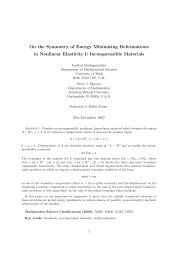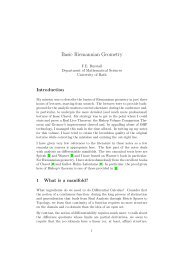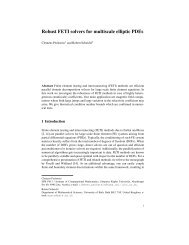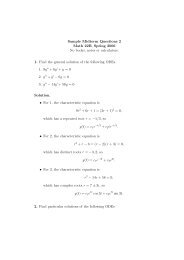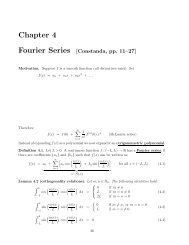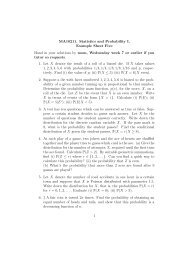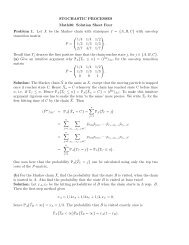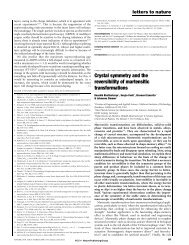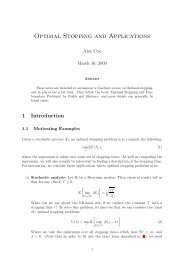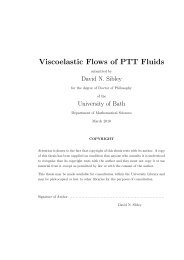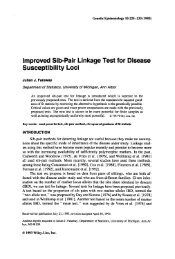1 Lévy Processes and Infinite Divisibility - Department of ...
1 Lévy Processes and Infinite Divisibility - Department of ...
1 Lévy Processes and Infinite Divisibility - Department of ...
You also want an ePaper? Increase the reach of your titles
YUMPU automatically turns print PDFs into web optimized ePapers that Google loves.
Exercise 8 Recall that D[0,1] is the space <strong>of</strong> functions f : [0,1] → R whichare right continuous with left limits.(i) Define the norm ||f|| = sup x∈[0,1] |f(x)|. Use the triangle inequality todeduce that D[0,1] is closed under uniform convergence with respect tothe norm ||·||. That is to say, show that if {f n : n ≥ 1} is a sequence inD[0,1] <strong>and</strong> f : [0,1] → R such that lim n↑∞ ||f n −f|| = 0 then f ∈ D[0,1].(ii) Suppose that f ∈ D[0,1] <strong>and</strong> let ∆ = {t ∈ [0,1] : |f(t)−f(t−)| ̸= 0} (theset <strong>of</strong> discontinuity points). Show that ∆ is countable if ∆ c is countablefor all c > 0 where ∆ c = {t ∈ [0,1] : |f(t)−f(t−)| > c}. Next fix c > 0.By supposing for contradiction that ∆ c has an accumulation point, say x,show that the existence <strong>of</strong> either a left or right limit at x fails as it wouldimply that there is no left or right limit <strong>of</strong> f at x. Deduce that ∆ c <strong>and</strong>hence ∆ is countable.Exercise 9 The explicit construction <strong>of</strong> a <strong>Lévy</strong> process given in the <strong>Lévy</strong>–Itôdecomposition begs the question as to whether one may construct examples <strong>of</strong>deterministic functions which have similar properties to those <strong>of</strong> the paths <strong>of</strong><strong>Lévy</strong>processes. The objective <strong>of</strong> this exercise is to do preciselythat. The readeris warned however, that this is purely an analytical exercise <strong>and</strong> one should notnecessarily think <strong>of</strong> the paths <strong>of</strong> <strong>Lévy</strong> processes as being entirely similar to thefunctions constructed below in all respects.(i) Let us recall the definition <strong>of</strong> the Cantor function which we shall use toconstruct a deterministic function which has bounded variation <strong>and</strong> thatis right continuous with left limits <strong>and</strong> whose points <strong>of</strong> discontinuity aredense in its domain. Take the interval C 0 := [0,1] <strong>and</strong> perform the followingiteration. For n ≥ 0 define C n as the union <strong>of</strong> intervals whichremain when removing the middle third <strong>of</strong> each <strong>of</strong> the intervals whichmake up C n−1 . The Cantor set C is the limiting object, ⋂ n≥0 C n <strong>and</strong> canbe described byC = {x ∈ [0,1] : x = ∑ k≥1α k3 k such that α k ∈ {0,2} for each k ≥ 1}.One sees then that the Cantor set is simply the points in [0,1] whichomits numbers whose tertiary expansion contain the digit 1. To describethe Cantor function, for each x ∈ [0,1] let j(x) be the smallest j for whichα j = 1 in the tertiary expansion <strong>of</strong> ∑ k≥1 α k/3 k <strong>of</strong> x. If x ∈ C thenj(x) = ∞ <strong>and</strong> otherwise if x ∈ [0,1]\C then 1 ≤ j(x) < ∞. The Cantorfunction is defined as followsf(x) = 1j(x)−12 + ∑ α ifor x ∈ [0,1].j(x) 2i+1 i=1Now consider the function g : [0,1] → [0,1] given by g(x) = f −1 (x)−axfor a ∈ R. Here we underst<strong>and</strong> f −1 (x) = inf{θ : f(θ) > x}. Note that g is30



